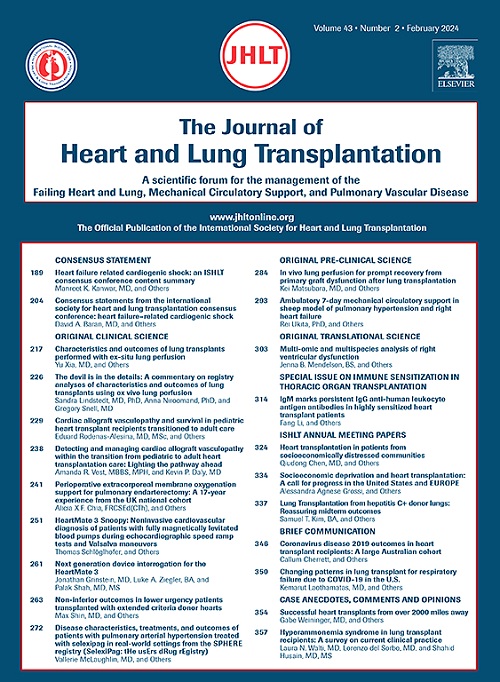Extended survival of 9- and 10-gene-edited pig heart xenografts with ischemia minimization and CD154 costimulation blockade-based immunosuppression
IF 6.4
1区 医学
Q1 CARDIAC & CARDIOVASCULAR SYSTEMS
引用次数: 0
Abstract
Background
Xenotransplantation has made significant advances recently using pigs genetically engineered to remove carbohydrate antigens, either alone or with addition of various human complement, coagulation, and anti-inflammatory ‘‘transgenes’’. Here we evaluated results associated with gene-edited (GE) pig hearts transplanted in baboons using an established costimulation-based immunosuppressive regimen and a cold-perfused graft preservation technique.
Methods
Eight baboons received heterotopic abdominal heart transplants from 3-GE (GalKO.β4GalNT2KO.hCD55, n = 3), 9-GE (GalKO.β4GalNT2KO.GHRKO.hCD46.hCD55. TBM.EPCR.hCD47. HO-1, n = 3) or 10-G (9-GE + CMAHKO, n = 2) pigs using Steen’s cold continuous perfusion for ischemia minimization. Immunosuppression (IS) included induction with anti-thymocyte globulin and αCD20, ongoing αCD154, MMF, and tapered corticosteroid.
Results
All three 3-GE grafts functioned well initially, but failed within 5 days. One 9-GE graft was lost intraoperatively due to a technical issue and another was lost at POD 13 due to antibody mediated rejection (AMR) in a baboon with a strongly positive pre-operative cross-match. One 10-GE heart failed at POD113 with combined cellular and antibody mediated rejection. One 9-GE and one 10-GE hearts had preserved graft function with normal myocardium on protocol biopsies, but exhibited slowly progressive graft hypertrophy until elective necropsy at POD393 and 243 respectively. Elevated levels of IL-6, MCP-1, C-reactive protein, and human thrombomodulin were variably associated with conditioning, the transplant procedure, and clinically significant postoperative events.
Conclusion
Relative to reference genetics without thrombo-regulatory and anti-inflammatory gene expression, 9- or 10-GE pig hearts exhibit promising performance in the context of a clinically applicable regimen including ischemia minimization and αCD154-based IS, justifying further evaluation in an orthotopic model.
基于缺血最小化和 CD154 Costimulation Blockade 的免疫抑制延长 9 基因和 10 基因编辑猪心脏异种移植的存活期
背景:最近,利用基因工程猪去除碳水化合物抗原,单独或添加各种人类补体、凝血和抗炎 "转基因 "进行异种移植取得了重大进展。在这里,我们评估了基因编辑(GE)猪心脏移植到狒狒体内的相关结果,这种移植采用了成熟的基于成本刺激的免疫抑制方案和冷灌注移植物保存技术:8只狒狒接受了来自3-GE(GalKO.β4GalNT2KO.hCD55,n=3)、9-GE(GalKO.β4GalNT2KO.GHRKO.hCD46.hCD55. TBM.EPCR.hCD47.HO-1,n=3)或10-G(9-GE+CMAHKO,n=2)猪的异位腹腔心脏移植,移植过程中使用了Steen冷持续灌注以减少缺血。免疫抑制(IS)包括抗胸腺细胞球蛋白和αCD20诱导、持续αCD154、MMF和渐进皮质类固醇:所有三例 3-GE 移植物起初功能良好,但在 5 天内均告失败。一个9-GE移植物由于技术问题在术中丢失,另一个在POD 13时丢失,原因是一只狒狒术前交叉配型呈强阳性,出现了抗体介导的排斥反应(AMR)。一个 10-GE 心脏在 POD113 时因合并细胞和抗体介导的排斥反应而失败。一颗9-GE和一颗10-GE心脏的移植功能保持良好,心肌活检结果正常,但表现出缓慢进行性移植肥大,分别于POD393和POD243进行择期尸检。IL-6、MCP-1、C反应蛋白和人血栓调节蛋白水平的升高与调理、移植过程和临床显著的术后事件有不同程度的关联:结论:与没有血栓调节和抗炎基因表达的参考遗传学相比,9-或10-GE猪心在临床适用的方案(包括缺血最小化和基于αCD154的IS)中表现出良好的性能,值得在正位模型中进一步评估。
本文章由计算机程序翻译,如有差异,请以英文原文为准。
求助全文
约1分钟内获得全文
求助全文
来源期刊
CiteScore
10.10
自引率
6.70%
发文量
1667
审稿时长
69 days
期刊介绍:
The Journal of Heart and Lung Transplantation, the official publication of the International Society for Heart and Lung Transplantation, brings readers essential scholarly and timely information in the field of cardio-pulmonary transplantation, mechanical and biological support of the failing heart, advanced lung disease (including pulmonary vascular disease) and cell replacement therapy. Importantly, the journal also serves as a medium of communication of pre-clinical sciences in all these rapidly expanding areas.

 求助内容:
求助内容: 应助结果提醒方式:
应助结果提醒方式:


